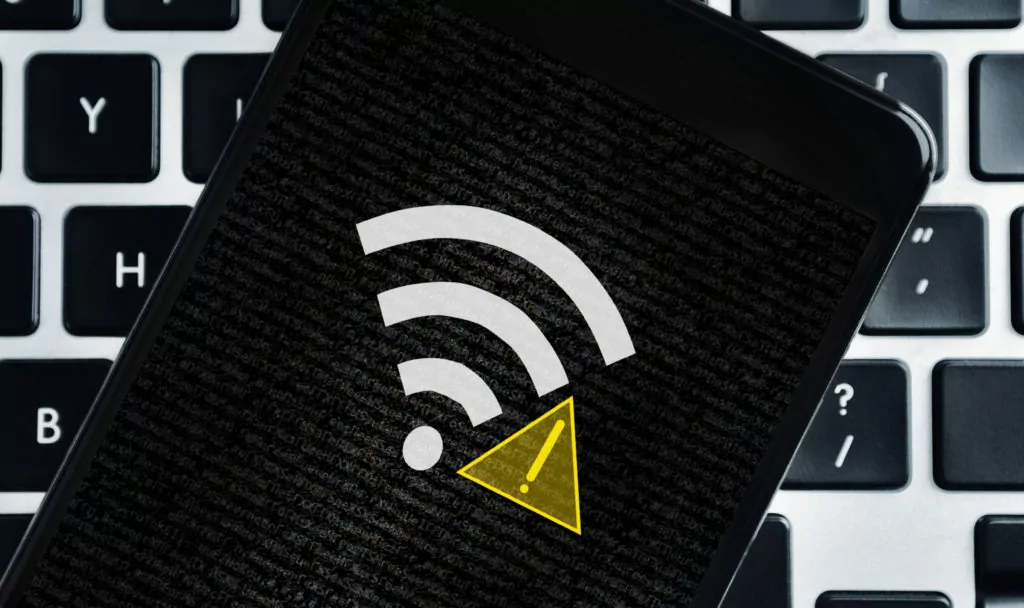Here’s why there’s an exclamation mark on your Wi-Fi symbol and how to fix it:
The Wi-Fi exclamation mark stands for no internet.
You can fix that by:
- Turn your device’s Wi-Fi off and back On
- Reboot your router
- Reset your router
- Check your network settings
- Update your router’s drivers
- Check for network outages
- Pay your internet bill
If you want to learn all about why your Wi-Fi internet isn’t working and how to fix it, then you’re in the right place.
Let’s dive right in!
- Faking Internet Outage: How To?
- 1.1.1.1 DNS: Safe?
- Plugging in Router Before Activation: What Then?
- ISP Blocking Ports: What to Do?
- ISP Blocking Port Forwarding: How to Know?
- FaceTime Poor Connection Issues: How to Fix?
- Internet Drops Every Hour or So?
- Internet Goes Out When It Rains: Why?

Why Is There an Exclamation Mark on Your Wi-Fi and How to Fix It?
It’s one of the digital age’s most frustrating impediments to productivity: the dreaded exclamation mark of doom.
Anyone who’s ever surfed the web wirelessly is likely familiar with this unsettling phenomenon.
Your device says you’re connected to the internet, but none of your apps or webpages are loading, and there’s an urgent-looking bit of punctuation overshadowing your ordinarily happy procession of Wi-Fi waves.
So, why is there an exclamation mark on your Wi-Fi?
When this harbinger of supreme inconvenience appears, it means you’re connected to Wi-Fi, but the internet is not working properly on your device.
In other words: major bummer.

Don’t start lighting candles and stockpiling bottled water just yet.
There are several potential solutions to the irksome Wi-Fi-signal-with-exclamation-point problem, whether you happen to have encountered it on your smartphone, tablet, laptop, or PC.
Most of them are quick, painless, and easy to carry out without any kind of technological wizardry.
Let’s get started:
What’s Going on With Your Wi-Fi?
Before you start blindly unplugging and resetting things, it’s a good idea to gain some understanding of why you’re running into this issue in the first place.
As tempting as it might be to just blame it on Al Gore, it’s more helpful to learn a little bit about what Wi-Fi is and how it controls your life.
Wi-Fi basically functions as a kind of sophisticated radio system. It has a transmitter (the router) and a receiver (the device you’re trying to watch cat videos on).
The router sends out waves containing special signals that allow the device to access the internet.
For this to happen, both the router and the receiving device must be configured correctly, which is why you always have to set up new electronics as soon as you take them out of the box.
Why Is There an Exclamation Mark on Your Wi-Fi?
With wireless internet signals, as with free Big Gulp refills, hiccups sometimes occur.
The router may not emit signals the way it’s supposed to, or any number of software errors may prevent the device from getting them.
Either way, you can be sure that the hangup lies on one end or the other.
Articulating the many ways that your wireless internet can end up FUBAR is a task best put off for another time, as it’s all rather technical and not strictly necessary for resolving the immediate crisis, which is that your one-person “Despacito” singalong party got cut off midway through.
Suffice it to say that the process of healing a failed internet connection is not unlike a doctor diagnosing a mysterious condition that’s presenting a host of vague symptoms:
It’s a matter of pinpointing the part that’s ailing and treating it directly. This sometimes involves a little trial and error.
Ready to start operating?
Here’s how to remove a Wi-Fi signal with an exclamation point from your mobile or home network:
#1 Turn Your Device’s Wi-Fi Off and Back On
Whenever you’re attempting to repair a broken Wi-Fi connection, a good rule of thumb is to always start with the link in the chain that’s closest to you.
In this case, it’s your smartphone, tablet, laptop, game console, or web-enabled SmartToaster™.
Head to your device’s settings menu and look for the Wi-Fi option.
You might also be able to find the function you’re looking for under the Network Settings hub if you’re getting an exclamation mark on a Wi-Fi laptop or PC.
Flip the Wi-Fi off, then wait long enough to whistle a few bars of “Dancing on the Ceiling” and reactivate it.

Toggling your device’s Wi-Fi off and on is the technological equivalent of starting your sentence over when you get hopelessly tongue-tied.
With any luck, the misdirected signals will sort themselves out and you’ll be back online in a few brief moments.
#2 Reboot Your Router
Let’s say your device’s connectivity checks out (one way to test whether this is the case on a smartphone or tablet is to switch off your Wi-Fi and see if you can perform basic online operations via LTE); this could be a clue that the culprit is the wireless router itself.
Track down the offending unit—it’s that funny little box collecting dust in the corner of your living room—and hit the Wi-Fi On/Off button exactly two times.
Easy peasy.
If you don’t spy an Off/Off button, you can also reboot your router using the main power switch or your computer’s Network Settings.
You can even disconnect the power cord entirely long enough to give it time to think about what it’s done.
Assuming the router indeed was the cause of the unforgivable disruption, you should be able to finish your 479th round of Candy Crush Saga once it’s up and running again. If not, it’s time to bring out the big guns.
#3 Reset Your Router
Locate the reset button on the backside of your router, but don’t push it just yet.
First, jot down your SSID (the name of your wireless network) and preferred password, along with any static IP addresses, DNS servers, or unique security settings you want to preserve.
Resetting your router is essentially employing the nuclear option—pushing the button will restore its original factory settings and erase your existing settings for good.
When you’re ready to rock and roll, look around for some sort of tiny poking implement (a straightened paper clip will do the trick), insert it into the hole, and hold down the recessed button for 10 full seconds before releasing it.
After your router wakes back up, it will behave like someone who just got flashed with the Neuralyzer from the “Men in Black” movies, so don’t be alarmed.
Simply plug the network settings you recorded earlier back into the appropriate slots in your router settings and you should be good to go.
Alternatively, you could take this opportunity to create and configure a new optimized network from the ground up.
After all, who doesn’t like the idea of a fresh start?
#4 A Quick Note on Network Settings
You can pull up all of your wireless network’s relevant details by going into your Network Settings, selecting your problematic wireless device, and open the “Properties” menu.
If you’re wondering how to fix an exclamation mark on Windows 10, follow these steps:
Windows 10 users can summon their network information through the Command Prompt window.
To do this, press the Windows button and R key together or type “cmd” into the Search box on the start menu, then punch in “ipconfig” and hit “Enter.”
That said, if you don’t know what these settings are or what they do, it’s probably best not to mess with them.
#5 Update Your Router’s Drivers
“Driver” is just a fancy industry term for a program that allows routers and other pieces of hardware to interface the way they’re supposed to with related devices.
Like any other type of software, drivers need to be updated regularly. They’re ordinarily designed to do this by themselves.
Sometimes, though, an update will go missed or fail altogether, in which case your internet may cease to function until the blunder is addressed.
Grab a plate and fork, because how to fix an exclamation mark on Wi-Fi with this method is a piece of cake.
To check the status of your router’s drivers on a personal computer, open your Device Manager (you can usually get to it from the start menu), navigate to the Network Adapters submenu, identify your wireless network adapter, right-click it, and choose “Update Driver.”
Once you’ve done that, specify that you want your computer to search for updates automatically, then sit back and wait for the process to complete.

If for some reason the update doesn’t take, show your computer you mean business by uninstalling the adapter completely.
You can then right-click the Network Adapters heading in your Device Manager and select “Scan for Hardware Changes.”
Your computer should automatically detect the router and begin installing it with all the necessary updates in tow.
#6 Check For Network Outages
Remember, anytime an exclamation mark of doom rains on your Wi-Fi parade, it means your device is in communication with your router, but it’s not receiving internet.
We’ve seen how this can be the result of a network brain fart, poorly configured router, or outdated driver.
More rarely, however, it might be due to a full-on internet outage in your neck of the woods.
The best way to get to the bottom of a suspected outage is to call your internet service provider (ISP) and see what’s up. They’ll be able to confirm a temporary failure and give you an idea of how long it will likely last.
While you’ve got someone on the phone, ask them if they offer mobile outage alerts.
Outage alerts can take much of the guesswork out of dealing with lapses in connectivity, as your provider will send you an automated message anytime their equipment goes down.
#7 Pay Your Internet Bill
Here’s a stimulating mental exercise for you: close your eyes and think back to the last time you paid for your internet service. Think hard. Can’t remember? That might explain your current predicament.
ISPs and other utility providers are notoriously poor sports and tend not to take it well when you make the innocent mistake of going months without paying for the resources they loan you.
With this bitter dose of reality fresh in mind, one last remote but not inconceivable possibility is that your ISP has shut off your internet service due to prolonged non-payment.
No judgies, but you’ll need to make up those missed payments pronto if you want to get back to binge-watching whole seasons of The Sopranos as soon as possible.

